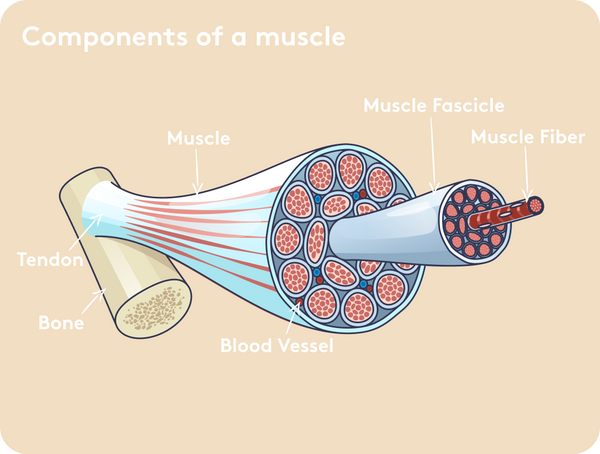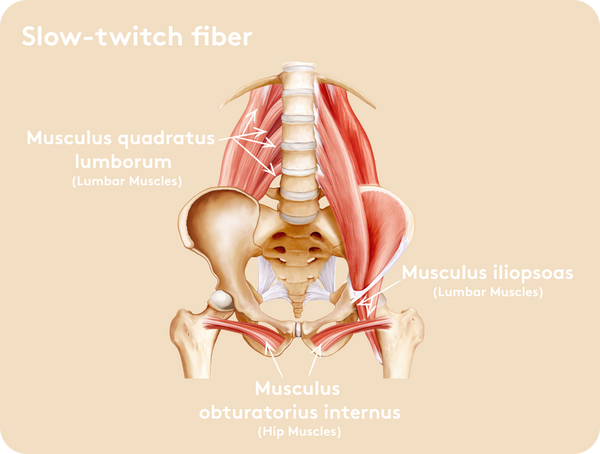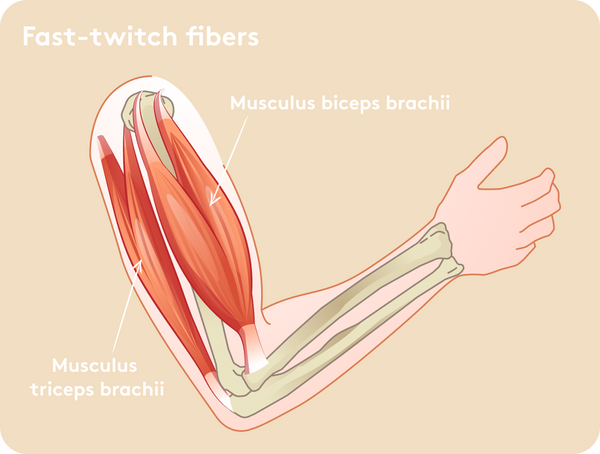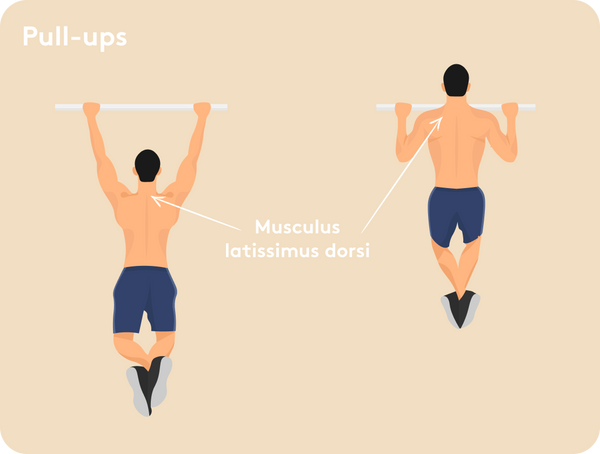Themen dieses Blogartikels:
Introduction
How to build muscle properly - tips from Strongman Frank Delventhal
Are you just starting strength training, want to build muscle and don't really know how to go about it? Are you looking for new training stimuli and a little theory about the muscles you are currently training? In both cases you are in the right place.
Here we have compiled all the relevant information on the subject of muscle building. In addition, you can expect an interview with our training pro and "Strongman" Frank Delventhal about his training plan for targeted muscle building. First, you will learn about the different types of muscles and the different ways to train them.
Here we have compiled all the relevant information on the subject of muscle building. In addition, you can expect an interview with our training pro and "Strongman" Frank Delventhal about his training plan for targeted muscle building. First, you will learn about the different types of muscles and the different ways to train them.
Table of Contents
• Muscle building - what exactly happens?
• Different types of muscles explained - which muscles are required in weight training?
• What does the term "strongman" mean in the context of Frank Delventhal?
• What does muscle building look like for Strongman Frank?
• Frank's Top 3 Training Exercises
• Frank's product recommendations for your training
• Bibliography
• Different types of muscles explained - which muscles are required in weight training?
• What does the term "strongman" mean in the context of Frank Delventhal?
• What does muscle building look like for Strongman Frank?
• Frank's Top 3 Training Exercises
• Frank's product recommendations for your training
• Bibliography
Muscle building - what exactly happens?
What exactly happens when you apply a training stimulus? What does this stimulus even look like for your muscle? Does the number of your muscle cells increase or do the cells just get bigger?
Your muscles consist of many muscle fibers. At the same time, these are muscle cells. Unlike other cells, these muscle cells are much longer, larger and also multinucleated. They are also called syncytia. These are cells with multiple nuclei. In your muscle cells, several, not yet fully developed, muscle cells fuse together to form one large fiber. This structure of the muscle ensures that a contraction can take place in a regulated manner and in full length. This is because these muscle fibers contain small protein units that contract during contraction, causing the entire fiber to decrease in length and visibly contract. If a muscle fiber were made up of many small cells, it would be much more difficult to contract together.
Your muscles consist of many muscle fibers. At the same time, these are muscle cells. Unlike other cells, these muscle cells are much longer, larger and also multinucleated. They are also called syncytia. These are cells with multiple nuclei. In your muscle cells, several, not yet fully developed, muscle cells fuse together to form one large fiber. This structure of the muscle ensures that a contraction can take place in a regulated manner and in full length. This is because these muscle fibers contain small protein units that contract during contraction, causing the entire fiber to decrease in length and visibly contract. If a muscle fiber were made up of many small cells, it would be much more difficult to contract together.

This structure of the muscle ensures that a contraction can take place in a regulated manner and in full length. This is because these muscle fibers contain small protein units that contract during contraction, causing the entire fiber to decrease in length and visibly contract. If a muscle fiber were made up of many small cells, it would be much more difficult to contract together.
During your training, you exert a force. This mechanical load is registered by the muscle fiber through various sensors[1] and causes the fiber to release, among other things, a muscle-specific growth factor that triggers anabolic, or anabolic, responses[2]. In addition, myoblasts, undifferentiated muscle cells that are in close proximity, are activated. They differentiate and fuse with the muscle fiber. Thus, another nucleus is added and the muscle has growth potential.
It is up for discussion to what extent small muscle damages during training, so-called micro traumas, contribute to muscle building. Colloquially, this is referred to as muscle soreness. This contributes to muscle growth because it promotes the activation of myoblasts and thus the muscle grows. However, muscle growth can also be observed without these small muscle damages.
Overall, we can state:
Your training stimulates muscle growth with mechanical stress, microtrauma, and possibly also with the altered metabolic state in the muscle (increased lactate production). This then occurs via the release of growth factors, the formation of new muscle proteins and fusion with myocytes. Thus, muscle growth is an enlargement of cells, not a new formation. This is called muscle hyperplasia.
During your training, you exert a force. This mechanical load is registered by the muscle fiber through various sensors[1] and causes the fiber to release, among other things, a muscle-specific growth factor that triggers anabolic, or anabolic, responses[2]. In addition, myoblasts, undifferentiated muscle cells that are in close proximity, are activated. They differentiate and fuse with the muscle fiber. Thus, another nucleus is added and the muscle has growth potential.
It is up for discussion to what extent small muscle damages during training, so-called micro traumas, contribute to muscle building. Colloquially, this is referred to as muscle soreness. This contributes to muscle growth because it promotes the activation of myoblasts and thus the muscle grows. However, muscle growth can also be observed without these small muscle damages.
Overall, we can state:
Your training stimulates muscle growth with mechanical stress, microtrauma, and possibly also with the altered metabolic state in the muscle (increased lactate production). This then occurs via the release of growth factors, the formation of new muscle proteins and fusion with myocytes. Thus, muscle growth is an enlargement of cells, not a new formation. This is called muscle hyperplasia.
Different types of muscles explained - which muscles are required in weight training?
We are not talking about leg, butt or arm muscles here. Rather, we are talking about different muscle fibers that make up the muscles mentioned.
We know that there are two types of muscle fibers in particular: Slow-twitch fibers and fast-twitch fibers, or muscle fibers type 1 and 2. In each muscle, these two types of muscle fibers are found. The ratio between them then determines the main function of the muscle.
What is the difference between these two fibers and which one do you use in your weight training?
We know that there are two types of muscle fibers in particular: Slow-twitch fibers and fast-twitch fibers, or muscle fibers type 1 and 2. In each muscle, these two types of muscle fibers are found. The ratio between them then determines the main function of the muscle.
What is the difference between these two fibers and which one do you use in your weight training?
Slow-twitch fibers - muscle fibers type 1
These fibers are also called red muscles. This is because they are particularly well supplied with blood and contain a high proportion of myoglobin. Myoglobin is a molecule that can store oxygen to a certain extent, so that more is available to the muscle at times of exertion. They are the typical endurance muscles because, as the name suggests, they contract more slowly, but can hold the contraction longer. This type of muscle is particularly abundant in supporting muscles such as the hip muscles. These type 1 fibers enable the muscle to hold the contraction, which has to be exerted when standing, for example, for much longer.
Red muscle is typically used primarily in endurance sports. Due to the high content of mitochondria, the energy power plants of our cells, as well as myoglobin, it is optimal for energy production with oxygen, which is used in endurance sports.
So jogging, cycling, swimming and other endurance sports primarily use slow-twitch fibers.
These fibers are also called red muscles. This is because they are particularly well supplied with blood and contain a high proportion of myoglobin. Myoglobin is a molecule that can store oxygen to a certain extent, so that more is available to the muscle at times of exertion. They are the typical endurance muscles because, as the name suggests, they contract more slowly, but can hold the contraction longer. This type of muscle is particularly abundant in supporting muscles such as the hip muscles. These type 1 fibers enable the muscle to hold the contraction, which has to be exerted when standing, for example, for much longer.
Red muscle is typically used primarily in endurance sports. Due to the high content of mitochondria, the energy power plants of our cells, as well as myoglobin, it is optimal for energy production with oxygen, which is used in endurance sports.
So jogging, cycling, swimming and other endurance sports primarily use slow-twitch fibers.

Fast-twitch fibers - muscle fibers type 2
Also called white muscle fibers, fast-twitch fibers contain little myoglobin and also fewer mitochondria. They are responsible for fast movement with high force development. Aerobic energy production in the mitochondria is too slow here. Fast-twitch fibers can also be distinguished between type 2a and 2b.
Type 2a fibers are fast-twitch fibers that can work oxidatively (with oxygen) and without oxygen (glycolytically). As a result, they fatigue more quickly. But not quite as fast as type 2b fibers, which work only without oxygen and with the muscle's reserves. They are the ones that can develop the most power, but fatigue the fastest.
During strength training, fast-twitch fibers are needed above all. These also significantly define the size of the muscle, which means that people who do endurance sports often look narrower than people who primarily do strength training.
Also called white muscle fibers, fast-twitch fibers contain little myoglobin and also fewer mitochondria. They are responsible for fast movement with high force development. Aerobic energy production in the mitochondria is too slow here. Fast-twitch fibers can also be distinguished between type 2a and 2b.
Type 2a fibers are fast-twitch fibers that can work oxidatively (with oxygen) and without oxygen (glycolytically). As a result, they fatigue more quickly. But not quite as fast as type 2b fibers, which work only without oxygen and with the muscle's reserves. They are the ones that can develop the most power, but fatigue the fastest.
During strength training, fast-twitch fibers are needed above all. These also significantly define the size of the muscle, which means that people who do endurance sports often look narrower than people who primarily do strength training.

What does the term "strongman" mean in the context of Frank Delventhal?
The term "strongman" comes from a niche of the entertainment scene. Even before there was television, particularly strong people were marveled at as an attraction. For example, the feat of strength of tearing a phone book. At that time, no real attention was paid to the athletic aspect of these feats. Today it is different. At the end of the 20th century, this initial display developed into a sport with competitions all over the world. However, the term "strongman" is defined differently by everyone.
Learn more about Frank
Are you interested in learning more about Frank's story? Then visit his website.
Frank says: "Actually, you could just say 'human being'. I know that the potential lies dormant in all of us. Unfortunately, many don't understand that. That's why I try to wake them up with my acts of strength, so they see that there's more to it and they can achieve that goal if they want to."
But who is Frank? Frank Delventhal is a "strongman" who uses his coaching to help others reach their full potential in sports. He had first turned to "strongman" sports through his own setbacks, especially physical ones. "At first, I just wanted to be pain-free and comfortable in my skin. Once I accomplished that, I just asked myself what else was possible."
But who is Frank? Frank Delventhal is a "strongman" who uses his coaching to help others reach their full potential in sports. He had first turned to "strongman" sports through his own setbacks, especially physical ones. "At first, I just wanted to be pain-free and comfortable in my skin. Once I accomplished that, I just asked myself what else was possible."

What does muscle building look like for "Strongman" Frank?
We asked Frank a few questions to give you some insight into his daily training routine and muscle building. As a primarily strength athlete, Frank focuses on strength training, but incorporates a lot of movement into his daily routine.
What does a typical "strongman" training day look like for you?
Frank: "There is no 100% typical day for me. My training depends on my current phase of my training and of course on how I feel. I listen to my body here. I think that's really important to stay on the ball in the long run. Monday is usually my 'strength day'. This is where I practice my strength acts like breaking chains with my chest or tearing up phone books. After the strength act workout, I typically need a week to recover from it before I can start my strength acts the next time."
What do your other training sessions look like?
Frank: "This is followed by three training days with a mixture of powerlifting, calisthenics, kettlebell exercises as well as mobility training. Recently, I had four normal training days. But then had trouble with recovery and cut that back a bit. This again shows how important breaks are. Right now I'm following a split training plan, so I train my legs on the training day after the strength sessions. After all, my shoulders and forearms are usually shot after the strength sessions."
What does a typical "strongman" training day look like for you?
Frank: "There is no 100% typical day for me. My training depends on my current phase of my training and of course on how I feel. I listen to my body here. I think that's really important to stay on the ball in the long run. Monday is usually my 'strength day'. This is where I practice my strength acts like breaking chains with my chest or tearing up phone books. After the strength act workout, I typically need a week to recover from it before I can start my strength acts the next time."
What do your other training sessions look like?
Frank: "This is followed by three training days with a mixture of powerlifting, calisthenics, kettlebell exercises as well as mobility training. Recently, I had four normal training days. But then had trouble with recovery and cut that back a bit. This again shows how important breaks are. Right now I'm following a split training plan, so I train my legs on the training day after the strength sessions. After all, my shoulders and forearms are usually shot after the strength sessions."
Good to know:
Wondering what exactly powerlifting, calisthenics and co. mean? Here we have a quick list for you:
Powerlifting: This competitive sport is composed of three disciplines: squats, bench press and deadlift.
Calisthenics: The term calisthenics includes exercises that work with your own body weight. Compared to classic strength training with isolated exercises, calisthenics is about coordination. The exercises address different muscle groups at once. The goal is often to improve stability and balance and to be able to practice dynamic movements more easily. The exercises are performed on bars of different heights and positions, which resemble the gymnastics apparatuses parallel bars and high bar.
Kettlebell: The kettlebell is a piece of exercise equipment used to perform a series of dynamic strength exercises, such as the "Kettlebell Swing". Kettlebell exercises typically utilize a range of joints and improve mobilization in addition to strength development.
Mobility training: Mobility training, as the name suggests, involves working on mobility. This is important in weight training because otherwise the muscles tend to stiffen and the joints become more immobile.
Powerlifting: This competitive sport is composed of three disciplines: squats, bench press and deadlift.
Calisthenics: The term calisthenics includes exercises that work with your own body weight. Compared to classic strength training with isolated exercises, calisthenics is about coordination. The exercises address different muscle groups at once. The goal is often to improve stability and balance and to be able to practice dynamic movements more easily. The exercises are performed on bars of different heights and positions, which resemble the gymnastics apparatuses parallel bars and high bar.
Kettlebell: The kettlebell is a piece of exercise equipment used to perform a series of dynamic strength exercises, such as the "Kettlebell Swing". Kettlebell exercises typically utilize a range of joints and improve mobilization in addition to strength development.
Mobility training: Mobility training, as the name suggests, involves working on mobility. This is important in weight training because otherwise the muscles tend to stiffen and the joints become more immobile.
As you can see, Frank puts a lot of focus on mobility and on his joints. And that's a good thing. Because many strength athletes have problems with their joints, especially as they get older, and they typically wear down and stiffen up a lot.
Also, do you follow a certain diet or pay special attention to anything?
Frank: "I don't follow a strict diet like the ketogenic diet or similar. However, mental and physical performance depend significantly on nutrition. Therefore, I generally make sure that I eat mostly beneficial foods for my goals. In practice, this means mainly a lot of vegetables and protein. I limit fats and carbohydrates. Still, I try to stay balanced. In general, there are no bad foods in my opinion - however, some foods should only be enjoyed in small amounts. Candy bars are rarely in there, unfortunately."
Do you also pay attention to the fats you eat, for example, or is it primarily about the calories?
Frank: "It's not just about the calories for me. I don't eat as much fat, but then I try to eat high-quality fats and oils like olive oil, fish oil and linseed oil. Also, when it comes to carbohydrates, I pay attention to complex carbohydrates and, of course, the amount. Too few carbs does increase fat loss for me, but that also leads to a lot of strength loss in the long run. As always, it's a weighing - and in my case, weighing (tracking). The step I can advise anyone to take is to cook for themselves. That's the best way to know what I'm eating at any given time."
Also, do you follow a certain diet or pay special attention to anything?
Frank: "I don't follow a strict diet like the ketogenic diet or similar. However, mental and physical performance depend significantly on nutrition. Therefore, I generally make sure that I eat mostly beneficial foods for my goals. In practice, this means mainly a lot of vegetables and protein. I limit fats and carbohydrates. Still, I try to stay balanced. In general, there are no bad foods in my opinion - however, some foods should only be enjoyed in small amounts. Candy bars are rarely in there, unfortunately."
Do you also pay attention to the fats you eat, for example, or is it primarily about the calories?
Frank: "It's not just about the calories for me. I don't eat as much fat, but then I try to eat high-quality fats and oils like olive oil, fish oil and linseed oil. Also, when it comes to carbohydrates, I pay attention to complex carbohydrates and, of course, the amount. Too few carbs does increase fat loss for me, but that also leads to a lot of strength loss in the long run. As always, it's a weighing - and in my case, weighing (tracking). The step I can advise anyone to take is to cook for themselves. That's the best way to know what I'm eating at any given time."
Frank's Top 3 Training Exercises
#1 Kettlebell Turkish Get Up (TGU)
The ritualized standing up with the kettlebell is a very good exercise to train body awareness, mobility and thus also strength. More important here than a particularly heavy weight is the correct technique. All muscles must work together in a coordinated manner during the TGU.
A common mistake is to go from one position to another immediately. First arrive at one position and take it perfectly. Only then move on. This way the technique does not suffer from the fast movements and the muscle groups can be addressed more specifically.

#2 Kettlebell Swing
The kettlebell swing is relatively easy to learn. Here the hips are used. Many people have problems with it at first, because the movement rarely occurs in everyday life. With time, however, you develop more torque and it becomes easier.
The most common mistake is that the knees go forward during the swing. The knees should stay where they are. Instead, the hips push backward.
The kettlebell swing is relatively easy to learn. Here the hips are used. Many people have problems with it at first, because the movement rarely occurs in everyday life. With time, however, you develop more torque and it becomes easier.
The most common mistake is that the knees go forward during the swing. The knees should stay where they are. Instead, the hips push backward.

#3 Klimmzug
Being able to pull yourself up somewhere can be essential for survival. For Frank, the pull-up is therefore a core exercise.
The typical problem is that most only target and use their biceps. The latissimus dorsi muscle is a broad-based back muscle that can pull the upper body towards the arm when the arm is fixed. Therefore, it is an important muscle when climbing or just doing a pull-up.
Practice makes perfect. Regular back training provides additional support for this muscle.
Being able to pull yourself up somewhere can be essential for survival. For Frank, the pull-up is therefore a core exercise.
The typical problem is that most only target and use their biceps. The latissimus dorsi muscle is a broad-based back muscle that can pull the upper body towards the arm when the arm is fixed. Therefore, it is an important muscle when climbing or just doing a pull-up.
Practice makes perfect. Regular back training provides additional support for this muscle.

Bibliography
[1]: Wackerhage, H., Schoenfeld, B. J., Hamilton, D. L. et al. (2019). Stimuli and sensors that initiate skeletal muscle hypertrophy following resistance exercise. Journal of applied physiology (Bethesda, Md. : 1985), 126(1), 30–43. https://doi.org/10.1152/japplphysiol.00685.2018
[2]: Yoshida, T., Delafontaine, P. (2020). Mechanisms of IGF-1-Mediated Regulation of Skeletal Muscle Hypertrophy and Atrophy. Cells, 9(9), 1970. https://doi.org/10.3390/cells9091970
[2]: Yoshida, T., Delafontaine, P. (2020). Mechanisms of IGF-1-Mediated Regulation of Skeletal Muscle Hypertrophy and Atrophy. Cells, 9(9), 1970. https://doi.org/10.3390/cells9091970


